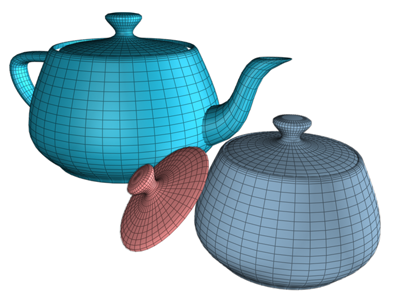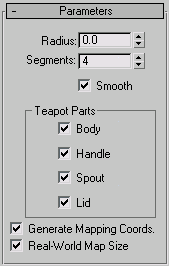The Teapot primitive produces a composite object comprising a lid, body, handle, and spout. You can choose to make the whole teapot at once (the default), or any combination of parts. Because the Teapot is a parametric object, you can choose which parts of the teapot to display after creation.

Examples of teapots
History of the CG Teapot
The Teapot primitive in 3ds Max derives from the original data developed by Martin Newell in 1975. Beginning with a graph-paper sketch of a teapot that he kept on his desk, Newell calculated cubic Bezier splines to create a wireframe model. James Blinn, also at the University of Utah during this period, produced early renderings of exceptional quality using this model.
The teapot has since become a classic shape in computer graphics. Its complex, curved, and intersecting surfaces are well suited to testing different kinds of material mappings and rendering settings on a real-world object.
Procedures
To create a teapot:
- On the Create panel or from the Create menu, choose Standard Primitives
 Teapot.
Teapot. - In any viewport, drag to define a radius.
As you drag, a teapot emerges with the pivot point at the center of its base.
- Release the mouse to set the radius and create the teapot.
- To exit teapot-creation mode, right-click in the viewport.
To create a single teapot part:
- In Parameters rollout
 Teapot Parts group, turn off all parts except the one you want to create.
Teapot Parts group, turn off all parts except the one you want to create. - Create a teapot.
The part you left on appears. The pivot point remains at the center of the teapot's base.
The teapot has four separate parts: body, handle, spout, and lid. Controls are located in the Teapot Parts group of the Parameters rollout. You can check any combination of parts to create at the same time. The body alone is a ready-made bowl, or a pot with optional lid.
To turn a part into a teapot:
- Select a teapot part in the viewport.
- On the Modify panel
 Parameters rollout, turn on all parts. (This is the default.)
Parameters rollout, turn on all parts. (This is the default.) The whole teapot appears.
You can apply modifiers to any separate part. If you later turn on another part, the modifier affects the additional geometry as well.
Interface
Creation Method rollout
- Edge
-
Draws a teapot from edge to edge. You can change the center location by moving the mouse.
- Center
-
Draws a teapot from the center out.
Parameters rollout

- Radius
-
The distance from the center of the teapot to the body perimeter; determines the overall size.
- Segments
-
The number of divisions of the teapot parts.
- Smooth
-
When on, blends faces of the teapot, creating a smooth appearance in rendered views.
Teapot Parts group
Toggle the checkboxes to enable/disable the different teapot parts. By default, all are on, producing a complete teapot.
- Generate Mapping Coords
-
Generates coordinates for applying mapped materials to the teapot. Default=on.
- Real-World Map Size
-
Controls the scaling method used for texture mapped materials that are applied to the object. The scaling values are controlled by the Use Real-World Scale settings found in the applied material's Coordinates rollout. Default=off.